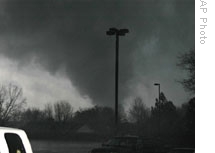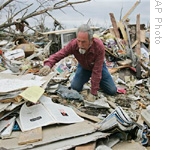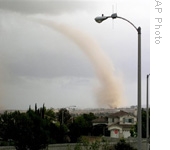VOA慢速英语-SCIENCE IN THE NEWS - This Year May Set Record for T
搜索关注在线英语听力室公众号:tingroom,领取免费英语资料大礼包。
(单词翻译)
More than 115 storm-related deaths have already been reported, making 2008 the deadliest year for tornadoes3 in the past 10 years. Transcript4 of radio broadcast:
14 July 2008
VOICE ONE:
This is SCIENCE IN THE NEWS in VOA Special English. I'm Bob Doughty5.
VOICE TWO:
 |
| Funnel6 cloud of a tornado2 that touched down in February in Atkins, Arkansas. Tornadoes hit four southern states in a rare burst of violent winter weather that killed at least 15 people. |
And I'm Shirley Griffith. On our program this week, we will tell about the science of tornadoes. Tornadoes have been observed in many parts of the world. But the storms are most often found in the United States. American weather experts say this year may set records for tornadoes and tornado deaths.
(MUSIC)
VOICE ONE:
A tornado is a violently turning tube of air suspended7 from a thick cloud. It extends9 from a thunderstorm in the sky down to the ground. The shape is like a funnel: wide at the top, narrower at the bottom.
Tornadoes form when winds blowing in different directions meet in the clouds and begin to turn in circles. Warm air rising from below causes the wind tube to reach toward10 the ground. Because of their circular11 movement, these severe windstorms are also known as twisters.
The most severe tornadoes can reach wind speeds of three hundred twenty kilometers an hour or more. In some cases, damage paths can stretch more than one kilometer wide and eighty kilometers long.
VOICE TWO:
With a tornado, bigger does not necessarily12 mean stronger. Large tornadoes can be weak. And some of the smallest tornadoes can be the most damaging. But no matter what the size, tornado winds are the strongest on Earth. Tornadoes have been known to carry homes, cars and trees from one place to another. And they can also destroy anything in their path.
Tornadoes have been observed on every continent except Antarctica. But weather experts say the country where they are most common is the United States. Each year, the United States has more than one thousand tornadoes.
VOICE ONE:
 |
| A man searches through the remains13 of a house destroyed by a tornado in Picher, Oklahoma, in May |
On average, tornadoes cause about seventy deaths and one thousand five hundred injuries in the United States each year. But weather experts say two thousand eight may set records for tornadoes and tornado-related deaths. Officials have already reported more than one hundred fifteen such deaths this year. This has been the deadliest year for the violent windstorms since nineteen ninety-eight.
Weather experts say unusually severe weather this winter and early spring may be to blame. Starting on February fifth, eighty-seven tornadoes struck the Tennessee Valley and central United States over a twenty-four hour period. Those storms resulted in fifty-six deaths. The experts also note that several tornadoes struck areas where large numbers of people live, causing more deaths and injuries.
(MUSIC)
VOICE TWO:
Tornadoes are observed most often in the central part of the United States, where the land is mostly flat. The area where the most violent tornadoes usually happen is known as “Tornado Alley14. ”This area is considered to extend8 from north central Texas to North Dakota.
Tornadoes can happen any time of the year. But most happen from late winter to the middle of summer. There is a second high season in November.
VOICE ONE:
During spring, warm air moves north and mixes with cold air remaining from winter. In November, the opposite happens. Cold weather moves south and combines with the last of the warm air from summer.
 |
| A tornado touches down in Riverside, California, in May |
Tornadoes can strike with little or no warning. Most injuries happen when flying objects hit people. Experts say the best place to be is in a small room, without windows, in the middle of the lowest part of a building.
People driving during a tornado are told to find low ground and lay flat, face down, with their hands covering their head. People in the path of a tornado often have just minutes to make life-or-death decisions.
VOICE TWO:
The deadliest American tornado on record is the Tri-State Tornado of March eighteenth, nineteen twenty-five. It tore across Missouri, Illinois and Indiana. About seven hundred people were killed.
A "tornado outbreak" is often defined15 as six or more tornadoes produced by the same weather system within a day. But the outbreak of April third and fourth, nineteen seventy-four, set a national record. It is remembered as the "Super Outbreak. "
One hundred forty-eight tornadoes struck during a twenty-four-hour period. More than three hundred people were killed and six thousand others were injured.
One tornado that was especially destructive16 hit Xenia, Ohio. The sound you are about to hear comes from the Web site www.xeniatornado.com.
(SOUND)
VOICE ONE:
No two tornadoes look exactly the same. And no two tornadoes act the same way.
It takes the right combination17 of wind, temperature, pressure and humidity18 to create even a weak tornado. Weather experts can identify these conditions. And, when they observe them, they can advise people that tornadoes might develop. But they are not able to tell exactly where or when a tornado will hit. Tornado warnings still depend in large part on human observations.
Usually a community will receive a warning at least a few minutes before a tornado strikes. But each year there are some surprises where tornadoes develop when they are least expected.
VOICE TWO:
The tornado reporting system involves watches and warnings. A tornado watch means tornadoes are possible in the area. A tornado warning means that a tornado has been seen. People are told to take shelter immediately.
Yet tornadoes can be difficult to see. Sometimes only the objects they are carrying through the air can be seen. Some nighttime tornadoes have been observed because of lightning strikes nearby. But tornadoes at night are usually impossible to see.
Tornadoes that form over water are called waterspouts. But tornadoes cover a much smaller area than hurricanes, which form over oceans.
Tornadoes can be measured using wind speed information from Doppler radar19 systems. Tornadoes usually travel in a northeasterly direction with a speed of thirty-two to sixty-four kilometers per hour. But they have been reported to move in other directions and as fast as one hundred seventeen kilometers an hour.
VOICE ONE:
In the United States, the force of a tornado is judged by the damage to structures. Scientists inspect the damage before they estimate20 the severity of a tornado. They measure tornadoes on the Fujita scale. Ted1 Fujita was a University of Chicago weather expert who developed this system in the nineteen seventies.
There are six levels on the Fujita scale. Tornadoes that cause only light damage are called an F-zero. Those with the highest winds that destroy well-built homes and throw vehicles more than one hundred meters are called an F-five.
(MUSIC)
VOICE TWO:
Some people make a sport out of watching and following tornadoes. They are called tornado chasers or storm chasers. Their work can be seen in the extreme weather videos that are increasingly21 popular on television.
Some chasers are part of weather research teams. Others do it to help document storms and warn the public. Still others do it just because it is their idea of fun.
Storm chasers usually drive large vehicles to areas of severe weather. They follow storms for long distances. For some, the appeal of a tornado is to get closer and take better pictures than others have, without getting killed in the process.
VOICE ONE:
The National Weather Service says the United States gets more severe weather than any other country. For one thing, it is also bigger than most other countries. And it has many different conditions that create many different kinds of weather.
There are seacoasts and deserts, flatlands and mountains. The West Coast is along the Pacific Ocean, which is relatively22 calm. The East Coast is along the Atlantic Ocean, which is known for its hurricanes. These strike mainly the Southeastern states.
The hurricane season officially began on June first and ends on November thirtieth.
(MUSIC)
VOICE TWO:
This SCIENCE IN THE NEWS was written by Brianna Blake, who was also our producer. I'm Shirley Griffith.
VOICE ONE:
And I'm Bob Doughty. Read and listen to our programs at voaspecialenglish. com. And if you have a science question, send it to special@voanews. com. We might be able to answer it on our show. Join us again next week for more news about science in Special English on the Voice of America.
 收听单词发音
收听单词发音 




